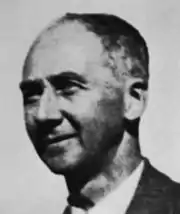Sydney Patterson
Sydney Wentworth Patterson MB BS, MD, DSc, FRCP (born 1882 in Melbourne, Australia, died 1960 in London, England) was a physician, medical researcher and first director of the Walter and Eliza Hall Institute of Medical Research in Melbourne, Australia.
Sydney Patterson | |
|---|---|
 | |
| Born | 1882 Melbourne, Australia |
| Died | 1960 London |
| Nationality | Australia |
| Scientific career | |
| Fields | Gastroenterology, physiology |
| Institutions | University College London, Walter and Eliza Hall Institute of Medical Research, Ruthin Castle |
Career
Education
Patterson was educated at Scotch College, Melbourne. He then obtained a scholarship from Ormond College to study at the University of Melbourne where he obtained first class honours in chemistry, physiology and medicine, graduating MB BS in 1904. In 1907 Patterson received his MD for research into calcium metabolism,[1] and in 1912 he was awarded a fellowship to undertake research with Ernest Starling at University College London. There he studied cardiac physiology and diabetes, earning the degree of Doctor of Science from the University of London in 1916.[2][3]
Military Service
During the First World War, Patterson joined the Australian Voluntary Medical Service, later transferring to the Royal Army Medical Corps. He was awarded the rank of Major and served as a pathologist in France. During this time he continued to undertake medical research, publishing a description of the bacteria associated with certain cases of fever in servicemen.[4]
Directorship of the Walter and Eliza Hall Institute
In 1919, Patterson was appointed as the first director of the Walter and Eliza Hall Institute.[5] He oversaw research programs in respiratory and intestinal microbiology, parasitology and cancer, with a focus on clinical research. Patterson established a structure of close collaboration with the Royal Melbourne Hospital. This included his appointment as a physician at the hospital and the involvement of many clinicians in medical research, often on a voluntary or part-time basis. He advocated for the institute to establish a clinical research ward, which was achieved several decades after his departure.[6][7]
When announcing Patterson's departure in 1923, The Argus newspaper described the Walter and Eliza Hall Institute as a national leader in the diagnosis of infectious diseases and cancer.[8]
Ruthin Castle Hospital
In 1923 Patterson left the institute to take an appointment as a clinician at Ruthin Castle, a private hospital in Wales (the successor of a hospital at Duff House in Scotland). He specialized in gastroenterology and was president of the British Society of Gastroenterology in 1954.
In 1958 Patterson retired from Ruthin Castle and returned to laboratory research into wound healing at University College London, until his death in 1960.[9]
References
- Biochem J. 1908;3(1-2):39-54. A Contribution to the Study of Calcium Metabolism S. W. Patterson
- "Dr. Patterson's New Appointment". The Argus. Melbourne. 4 April 1923. p. 9. Retrieved 17 June 2011 – via National Library of Australia.
- Macfarlane Burnet, Walter and Eliza Hall Institute 1915–1965 (Melbourne: Melbourne University Press, 1971).
- Br Med J. 1917 Sep 29;2(2961):418-9. Spirochaetes Occurring in the Urine of Cases of "Pyrexia of Unknown Origin." Patterson SW. ]
- "INSTITUTE OF RESEARCH". The Argus. Melbourne. 16 June 1919. p. 4. Retrieved 20 June 2011 – via National Library of Australia.
- Macfarlane Burnet, Walter and Eliza Hall Institute 1915–1965 (Melbourne: Melbourne University Press, 1971).
- The Medical Journal of Australia 1923 April 14 1(15):393-396. The Walter and Eliza Hall Institute of Research in Pathology and Medicine in Melbourne. Patterson SW.
- "PROGRESS IN PATHOLOGY". The Argus. Melbourne. 4 April 1923. p. 9. Retrieved 20 June 2011 – via National Library of Australia.
- Obituary: SW Patterson, MD DSc FRCP Br Med J 1 : 1575 doi:10.1136/bmj.1.5185.1575 (Published 21 May 1960)